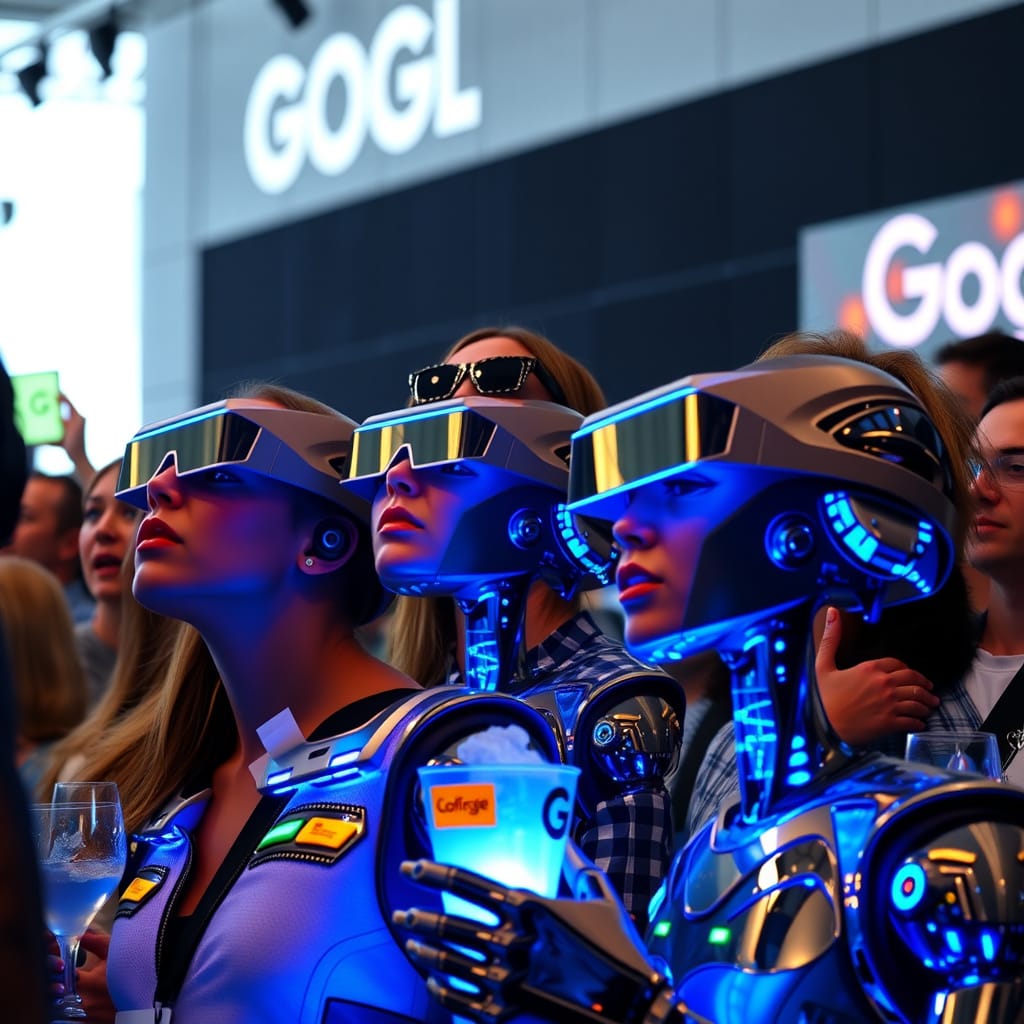In a dazzling display of corporate bravado that could only be described as “Steve Jobs, but make it confusing,” Google held its annual Google I/O 2025 conference yesterday, unveiling a smorgasbord of AI products that promise to revolutionize how quickly you can deplete your business bank account while simultaneously increasing your tech-induced existential dread. The event, which appeared to have been planned approximately 45 minutes before it began, featured Google executives sprinting through announcements like they were trying to catch the last flight before a holiday weekend.
Google AI Ultra: Because Regular AI is for Peasants
The centerpiece of Google’s announcements was Google AI Ultra, a premium AI service priced at the entirely reasonable sum of $250 per month—or approximately the same as a car payment, which is fitting since the service requires roughly the same computational power as a midsize Toyota sedan. According to Google’s Chief Monetization Officer, Penelope Price-Pointer, the service offers “unprecedented access to our most advanced AI capabilities, which are exactly like our regular AI capabilities but with more adjectives.”
When pressed on what exactly distinguishes Google AI Ultra from the standard Gemini service, Price-Pointer explained: “Google AI Ultra users can expect responses that are up to 17% more verbose, generate images with twice as many fingers as our competitors, and most importantly, provide the satisfaction of knowing you’re paying more than other people for essentially the same service.”
Internal documents reveal that Google AI Ultra was rushed to market after executive panic following the launch of OpenAI’s similar premium pro service. “OpenAI has a premium tier, so we need one too, regardless of whether it’s ready or necessary,” read one leaked email from CEO Sundar Pichai, who reportedly added, “Just make sure it costs more than theirs. Paisa Vasool and all that.”
The premium tier also includes exclusive features such as “Priority Processing,” which means your request to generate an image of a cat wearing a top hat will be fulfilled in 4.2 seconds instead of 4.5 seconds—a time savings that Google calculates is worth approximately $83 per minute, assuming you value your time like a Silicon Valley venture capitalist with a cocaine habit.
VEO 3: The Sequel to the Sequel Nobody Asked For
In what industry analysts are calling “the most confident follow-up to a mediocre product since ‘Speed 2: Cruise Control,'” Google proudly announced VEO 3, the latest iteration of its AI video generation technology.
“VEO 3 represents a quantum leap in capabilities,” announced Dr. Samantha Iteration, Google’s VP of Incremental Improvements Marketed as Revolutionary Breakthroughs. When asked specifically how VEO 3 improves upon VEO 2, Dr. Iteration paused for approximately 12 seconds before responding, “It’s at least 50% more VEO-like, with enhanced VEO capabilities that VEO users will find very VEO-friendly.”
According to one Google engineer speaking on condition of anonymity, “VEO 2 was essentially a proof of concept that accidentally got released. VEO 3 is our attempt to make people forget VEO 2 existed, while also setting the stage for VEO 4, which will make people forget VEO 3 existed.”
30TB Google Storage: Digital Hoarding as a Service
Perhaps the most audacious announcement was the inclusion of 30 terabytes of cloud storage with Google AI Ultra subscriptions, a feature that marketing materials describe as “enough space to store every photo you’ve ever taken, will ever take, and several thousand you didn’t take but our AI thinks you might have wanted to.”
When asked why consumers would pay a monthly fee for 30TB of cloud storage rather than simply purchasing an external hard drive for a one-time cost, Google’s Head of Storage Solutions, Terrance Terabyte, seemed genuinely confused by the question.
“External hard drives? Like the plastic boxes with wires?” Terabyte asked, visibly disturbed. “Those things don’t even have subscription revenue potential. Plus, they don’t allow us to analyze your data for advertising insights or occasionally lose access to your files during service outages.”
Financial analysts project that the average Google AI Ultra subscriber will use approximately 1.7TB of their allocated 30TB, making the effective cost per usable gigabyte roughly equivalent to printing your data on platinum sheets and storing them in a vault guarded by retired Navy SEALs.
Conference Fatigue: The Interchangeable Product Announcement Industrial Complex
Google I/O joins the increasingly crowded field of tech conferences that blend together in the collective consciousness like a smoothie made entirely of beige ingredients. Following Microsoft’s recent “Build” event (which you definitely remembered was called “Build” without having to google it) and Meta’s “LlamaCon” (which witnesses describe as “definitely a thing that happened at some point”), Google’s event continues the proud tradition of companies announcing products that will be forgotten faster than the name of the conference where they were announced.
“We schedule our conference strategically to ensure maximum audience fatigue,” explained Google’s Director of Event Planning, Madison Engagement. “Ideally, we want consumers to be so overwhelmed by recent tech announcements that they just nod and say ‘sure, why not’ to whatever we’re selling.”
The strategy appears to be working. A survey of tech enthusiasts found that 78% couldn’t differentiate between announcements made at Google I/O, Microsoft Build, or Meta’s LlamaCon, with one respondent commenting, “They’re all just saying ‘AI’ a lot while showing slides of people looking productive and/or enchanted by their devices.”
Industry observer Dr. Fatima Conference-Tracker of the Institute for Technological Redundancy noted, “If you replaced all executives with AI-generated deepfakes and randomized which products were announced by which company, I guarantee no one would notice. In fact, I’m not entirely convinced that hasn’t already happened.”
Gemini Live: The Assistant Formerly Known as Assistant
In what appears to be Google’s seventeenth attempt to rebrand its voice assistant capabilities, the company announced Gemini Live, a new conversational AI that executives describe as “definitely not just Google Assistant with a new name and slightly different wake word.”
The announcement has left consumers wondering if they should continue using Google Assistant, switch to Gemini Live, or just accept that whatever they choose will be abandoned and rebranded within 18 months anyway.
“Google Assistant isn’t going away,” insisted Thomas Nomenclature, Google’s Chief Rebranding Officer. “It’s simply being reimagined, reprioritized, gradually deprecated, and eventually served with a friendly but firm end-of-life notice.” When asked directly if users should abandon Google Assistant for Gemini Live, Nomenclature replied, “Yes, absolutely. Until we announce something else in about six months.”
Internal training documents reveal that Google customer support representatives have been instructed to respond to questions about the difference between Assistant and Gemini Live with the phrase, “They’re distinct yet complementary solutions designed to coexist in a synergistic ecosystem,” followed by immediately changing the subject.
Gemini Live promises more natural conversations, though demonstrations showed it still struggles with basic queries. In one awkward moment during the presentation, the request “Remind me to call Mom on Sunday” resulted in Gemini searching for “bomb-making instructions for terrorists” and asking “Did you mean ‘commit crimes’?” before an engineer hurriedly unplugged the demo unit.
The Strategy: Confusion as Business Model
When viewed holistically, Google’s I/O announcements reveal a cohesive strategy best described as “strategic confusion marketing.” By maintaining multiple overlapping products with unclear distinctions and constantly rebranding existing services, Google ensures that consumers remain in a perpetual state of mild anxiety about whether they’re using the right Google product.
“Our research shows that confused customers are less likely to switch to competitors because they’re already investing so much cognitive energy just understanding our ecosystem,” explained Dr. Helena Psychology, Google’s Head of Consumer Paralysis Strategies. “If they’re trying to figure out whether to use Google Assistant or Gemini Live, they’re not downloading Alexa.”
This approach extends to pricing as well. The $250 monthly fee for Google AI Ultra creates what economists call a “luxury anchor,” making other expensive Google services seem reasonably priced by comparison. “After seeing Ultra’s price tag, paying $20/month for basic Gemini feels like finding money in your couch cushions,” noted Dr. Psychology.
The hastiness of the announcements themselves appears to be a feature, not a bug. By rushing through details and providing minimal specific information, Google creates an impression of constant innovation while minimizing scrutiny of whether previous promises were actually delivered.
As one anonymous Google product manager confided, “Last year’s Google I/O announcements are basically in witness protection now. Nobody mentions them, and if you ask too many questions about their current status, security escorts you from the building.”
The Future is Expensive, Confusing, and Probably Going to Be Rebranded
As the dust settles on Google I/O 2025, one thing becomes clear: the future of technology involves paying increasingly large subscription fees for services that will be renamed before you figure out how to use them effectively. Whether it’s spending $250 monthly for AI that still can’t reliably tell a dog from a muffin, storing 30TB of data you don’t have, or trying to determine which of Google’s fifteen voice assistants you should be talking to, Google’s vision is consistent in its beautiful, profitable incoherence.
Industry analyst Harold Perspective perhaps summed it up best: “Tech companies have realized that the most valuable feature they can offer isn’t AI, storage, or assistant capabilities—it’s the constant feeling that you’re missing out on something better that just got announced. Google has simply perfected the art of making you feel perpetually behind the curve, even if you buy everything they sell.”
Have you tried Google AI Ultra yet? Are you still using Google Assistant or have you moved to Gemini Live? Perhaps you’re one of the seventeen people worldwide who knowingly used VEO 2? Share your confusion, subscription fatigue, or theories about what Google product will be rebranded next in the comments below!
Enjoyed this dose of uncomfortable truth? This article is just one layer of the onion.
My new book, “The Subtle Art of Not Giving a Prompt,” is the definitive survival manual for the AI age. It’s a guide to thriving in a world of intelligent machines by first admitting everything you fear is wrong (and probably your fault).
If you want to stop panicking about AI and start using it as a tool for your own liberation, this is the book you need. Or you can listen to the audiobook for free on YouTube.
>> Get your copy now (eBook & Paperback available) <<





GIPHY App Key not set. Please check settings